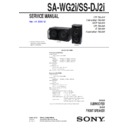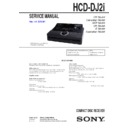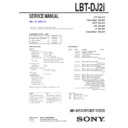Read Sony LBT-DJ2I / SA-WG2I / SS-DJ2I Service Manual online
SERVICE MANUAL
Sony Corporation
Audio&Video Business Group
Published by Sony Techno Create Corporation
SA-WG2i/SS-DJ2i
SA-WG2i
SUBWOOFER
SS-DJ2i
FRONT SPEAKER
9-889-187-05
2008L04-1
©
2008.12
US Model
Canadian Model
AEP Model
UK Model
E Model
Australian Model
Ver. 1.4 2008.12
• SA-WG2i/SS-DJ2i are the
subwoofer and front speaker
section in LBT-DJ2i.
subwoofer and front speaker
section in LBT-DJ2i.
SPECIFICATIONS
Front speaker (SS-DJ2i)
Speaker system
Speaker system
3-way, 3-driver, Bass refl ex
Speaker unit
Woofer: 130
Woofer: 130
mm
(5
1
/
2
inches), cone type
Subwoofer:
130
mm
(5
1
/
2
inches), cone type
Tweeter: 40
mm
(1
1
/
2
inches), horn type
Rated impedance
6
6
ohms
Dimensions (w/h/d)
Approx.
Approx.
205
× 381 × 248 mm
(8
1
/
8
× 15 × 9
7
/
8
inches)
Mass Approx. 4.0 kg (8 lb 14 oz) net per speaker
Subwoofer (SA-WG2i)
Subwoofer system
Subwoofer system
1-way, 2-driver, Bass refl ex
Speaker unit
Subwoofer:
180 mm (7 inches), cone type
Rated impedance
6
6
ohms
Dimensions (w/h/d)
Approx.
Approx.
500
× 306 × 505 mm
(19
3
/
4
× 12
1
/
8
× 20 inches)
Mass Approx. 16.5 kg (36 lb 7 oz)
Power requirements
Power requirements
Noth American model: 120 V AC, 60 Hz
European model:
230 V AC, 50/60 Hz
Mexican model:
127 V AC, 60 Hz
Oceanian model:
230 – 240 V AC, 50/60 Hz
Saudi Arabian model: 120 – 127 V, 220 V or 230 – 240 V AC,
50/60 Hz, adjustable with voltage selector
Other models:
120 V, 220 V or 230 – 240 V AC,
50/60 Hz, adjustable with voltage selector
Design and specifi cations are subject to change without notice.
SA-WG2i
SS-DJ2i
SA-WG2i/SS-DJ2i
2
SAFETY-RELATED COMPONET WARNING!
COMPONENTS IDENTIFIED BY MARK
0 OR DOTTED LINE
WITH MARK
0 ON THE SCHEMATIC DIAGRAMS AND IN
THE PARTS LIST ARE CRITICAL TO SAFE OPERATION.
REPLACE THESE COMPONENTS WITH SONY PARTS
REPLACE THESE COMPONENTS WITH SONY PARTS
WHOSE PART NUMBERS APPEAR AS SHOWN IN THIS
MANUAL OR IN SUPPLEMENTS PUBLISHED BY SONY.
MANUAL OR IN SUPPLEMENTS PUBLISHED BY SONY.
ATTENTION AU COMPOSANT AYANT RAPPORT
À LA SÉCURITÉ!
LES COMPOSANTS IDENTIFIÉS PAR UNE MARQUE
0 SUR
LES DIAGRAMMES SCHÉMATIQUES ET LA LISTE DES
PIÈCES SONT CRITIQUES POUR LA SÉCURITÉ DE FONC-
TIONNEMENT. NE REMPLACER CES COMPOSANTS QUE
PAR DES PIÈCES SONY DONT LES NUMÉROS SONT DON-
NÉS DANS CE MANUEL OU DANS LES SUPPLÉMENTS
PUBLIÉS PAR SONY.
PIÈCES SONT CRITIQUES POUR LA SÉCURITÉ DE FONC-
TIONNEMENT. NE REMPLACER CES COMPOSANTS QUE
PAR DES PIÈCES SONY DONT LES NUMÉROS SONT DON-
NÉS DANS CE MANUEL OU DANS LES SUPPLÉMENTS
PUBLIÉS PAR SONY.
UNLEADED SOLDER
Boards requiring use of unleaded solder are printed with the lead-
free mark (LF) indicating the solder contains no lead.
(Caution: Some printed circuit boards may not come printed with
Boards requiring use of unleaded solder are printed with the lead-
free mark (LF) indicating the solder contains no lead.
(Caution: Some printed circuit boards may not come printed with
the lead free mark due to their particular size)
: LEAD FREE MARK
Unleaded solder has the following characteristics.
• Unleaded solder melts at a temperature about 40 °C higher
• Unleaded solder melts at a temperature about 40 °C higher
than ordinary solder.
Ordinary soldering irons can be used but the iron tip has to be
applied to the solder joint for a slightly longer time.
applied to the solder joint for a slightly longer time.
Soldering irons using a temperature regulator should be set to
about 350 °C.
Caution: The printed pattern (copper foil) may peel away if
about 350 °C.
Caution: The printed pattern (copper foil) may peel away if
the heated tip is applied for too long, so be careful!
• Strong
viscosity
Unleaded solder is more viscous (sticky, less prone to fl ow)
than ordinary solder so use caution not to let solder bridges
occur such as on IC pins, etc.
than ordinary solder so use caution not to let solder bridges
occur such as on IC pins, etc.
•
Usable with ordinary solder
It is best to use only unleaded solder but unleaded solder may
also be added to ordinary solder.
also be added to ordinary solder.
NOTES ON CHIP COMPONENT REPLACEMENT
•
•
Never reuse a disconnected chip component.
•
Notice that the minus side of a tantalum capacitor may be dam-
aged by heat.
aged by heat.
1.
SERVICE NOTE
......................................................
3
2. GENERAL
...................................................................
4
3. DISASSEMBLY
3-1. Rear
Cover
Assy
............................................................. 6
3-2. POWER
AMP
Board
...................................................... 6
4. DIAGRAMS
4-1. Block
Diagram
................................................................ 7
4-2. Printed Wiring Board – Power Amp Section – ............... 9
4-3. Schematic Diagram – Power Amp Section – .................. 10
4-4. Printed Wiring Board – Trans Section – ......................... 11
4-5. Schematic Diagram – Trans Section – ............................ 12
4-3. Schematic Diagram – Power Amp Section – .................. 10
4-4. Printed Wiring Board – Trans Section – ......................... 11
4-5. Schematic Diagram – Trans Section – ............................ 12
5. EXPLODED
VIEW
5-1. Front Panel Section (SA-WG2i) ..................................... 13
5-2. Amp Section (1) (SA-WG2i) .......................................... 14
5-3. Amp Section (2) (SA-WG2i) .......................................... 15
5-4. Overall Section (SS-DJ2i) .............................................. 16
5-2. Amp Section (1) (SA-WG2i) .......................................... 14
5-3. Amp Section (2) (SA-WG2i) .......................................... 15
5-4. Overall Section (SS-DJ2i) .............................................. 16
6.
ELECTRICAL PARTS LIST .............................. 17
TABLE OF CONTENTS
SAFETY CHECK-OUT (US MODEL)
After correcting the original service problem, perform the follow-
ing safety check before releasing the set to the customer:
Check the antenna terminals, metal trim, “metallized” knobs,
screws, and all other exposed metal parts for AC leakage.
Check leakage as described below.
After correcting the original service problem, perform the follow-
ing safety check before releasing the set to the customer:
Check the antenna terminals, metal trim, “metallized” knobs,
screws, and all other exposed metal parts for AC leakage.
Check leakage as described below.
LEAKAGE TEST
The AC leakage from any exposed metal part to earth ground and
from all exposed metal parts to any exposed metal part having a
return to chassis, must not exceed 0.5 mA (500 microamperes.).
Leakage current can be measured by any one of three methods.
1. A commercial leakage tester, such as the Simpson 229 or RCA
The AC leakage from any exposed metal part to earth ground and
from all exposed metal parts to any exposed metal part having a
return to chassis, must not exceed 0.5 mA (500 microamperes.).
Leakage current can be measured by any one of three methods.
1. A commercial leakage tester, such as the Simpson 229 or RCA
WT-540A. Follow the manufacturers’ instructions to use these
instruments.
instruments.
2. A battery-operated AC milliammeter. The Data Precision 245
digital multimeter is suitable for this job.
3. Measuring the voltage drop across a resistor by means of a
VOM or battery-operated AC voltmeter. The “limit” indication
is 0.75 V, so analog meters must have an accurate low-voltage
scale. The Simpson 250 and Sanwa SH-63Trd are examples
of a passive VOM that is suitable. Nearly all battery operated
digital multimeters that have a 2 V AC range are suitable. (See
Fig. A)
is 0.75 V, so analog meters must have an accurate low-voltage
scale. The Simpson 250 and Sanwa SH-63Trd are examples
of a passive VOM that is suitable. Nearly all battery operated
digital multimeters that have a 2 V AC range are suitable. (See
Fig. A)
1.5 k
Ω
0.15
μF
AC
voltmeter
(0.75 V)
voltmeter
(0.75 V)
To Exposed Metal
Parts on Set
Parts on Set
Earth Ground
Fig. A. Using an AC voltmeter to check AC leakage.
SA-WG2i/SS-DJ2i
3
SECTION 1
SERVICE NOTE
Note for Repairing of the SA-WG2i
The SA-WG2i has no power switch and cannot be operated singly. Be sure to cannot the set to the HCD-DJ2i when performing service
and inspection.
The SA-WG2i has no power switch and cannot be operated singly. Be sure to cannot the set to the HCD-DJ2i when performing service
and inspection.
SA-WG2i/SS-DJ2i
4
SECTION 2
GENERAL
This section is extracted
from instruction manual.
from instruction manual.
13
GB
Getting
Star
ted
Hooking up the system
" Antennas
Find a location and an orientation that
provide good reception, and then set up
the antennas.
The FM 75
provide good reception, and then set up
the antennas.
The FM 75
Ω COAXIAL jack varies
according to models.
Note
Keep the antennas away from the speaker cords,
the power cord and the USB cable to avoid
picking up noise.
the power cord and the USB cable to avoid
picking up noise.
# LINE IN 1 L/R
,
LINE IN 2 L/R jacks
Use an audio cord to connect to the audio
output jacks of an optional component
(such as a portable audio player).
output jacks of an optional component
(such as a portable audio player).
Getting Started
$
"
%
#
#
&
'
(
To AM loop antenna
To FM lead antenna
From subwoofer
To front speakers
To FM lead antenna
From subwoofer
To front speakers
Unit (Left panel)
Unit (Right panel)
Subwoofer (Rear panel)
FM 75
C
O
AXIAL
AM
Extend the
FM lead
antenna
horizontally
FM lead
antenna
horizontally
AM loop
antenna
antenna
Continued
M



